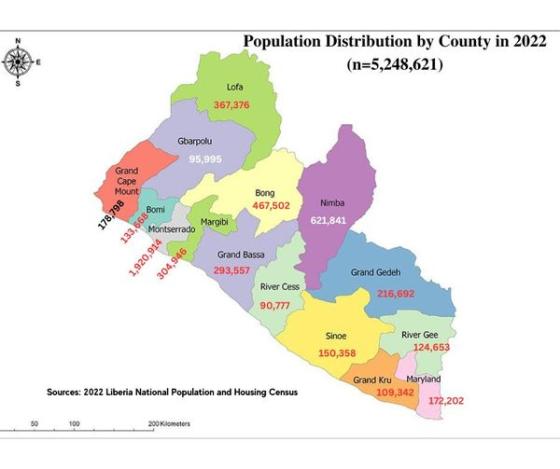Liberia’s Population Grows by 1.7 million people

Population map released by Liberia Institute of Statistics and Geo-Information Services (LISGIS)
— The data also shows that 50.4 percent of the country’s 5.2 million people are male, while the female population accounts for 49.6 percent — giving a national sex ratio of 101.5 males for every 100 females.
The population of Liberia has increased by almost two million, with Montserrado and Nimba counties accounting for nearly half of the overall population.
The provisional result of the 2022 National Census released by the Liberia Institute of Statistics and Geo-Information Services (LISGIS) yesterday revealed that the country’s population stands at 5.2 million, an increase of 50. 4 percent when compared with the 2008 census result, which was 3.5 million.
This represents a population gain of over 1.7 million people in the space of 14 years with urban growth up by 52 percent, while rural growth is down by 48 percent.
The gain is being attributed to “natural” change, the surplus of births compared with deaths. In 2022, the rate for Liberia was 4 births per woman, a gradual decline from 6.7 births per woman in 1973.
While the full census results are anticipated in May, they may be comparable to the World Bank forecast of 5.3 million people in 2022 – an average annual growth rate of 2.56%.
The data also shows that 50.4 percent of the country’s 5.2 million people are male, while the female population accounts for 49.6 percent — giving a national sex ratio of 101.5 males for every 100 females.
It is the same as the 2008 census result, where the female population was 49.4 percent compared to 50.6 percent population — given a sex ratio of 102.3 — which was the same as that for 1984.
Estimates for each county showed that population growth in Liberia remained heavily concentrated in four counties — Montserrado, Nimba, Bong, and Lofa County.
These counties constitute nearly two-thirds or 65 percent of the total population — following a similar pattern in 2008 and are in many ways long-term national trends of what is to come as their economic booms when compared to the rest of the other counties.
The counties sharing the less population are Rivercess, Gbarpolu, Grand Kru, and River Gee. These counties are among the poorest in the country, lacking basic social services, fueled by decades of government neglect.
The population growth rate, according to LISGIS, the country’s census house, stands at 3 percent with an average household size of 4.4 persons — representing a decrease — which has been so since 1984.
Household size declined from 6.2 persons in 1984 to 5.1, which implies that in a situation of increasing urbanization and modernization, household size will reduce.
Compared with a few countries in West Africa, Liberia's household size is more than Ghana and the Ivory Coast, but lesser than Sierra Leone and Mali, LISGIS data shows.
Also, Liberia’s population growth rate is higher than that of Ghana, Guinea, and the Ivory Coast, but lower than that of Mali and Sierra Leone.
Meanwhile, the provisional result of the 2022 Liberian census, the fifth in the nation’s history, saw nearly two million households being enumerated. The population density was then revealed as 140 persons per square mile — an increase of 43 persons.
In 2008, the population density of Liberia was 93 persons per square mile — representing a 66 percent rise over the figure of 56 attained in 1984.
Historically, Liberia has only held a census only four times in its history. They were in 1962 (1.1m); then in 1974 (1.5m); 1984 (2.1m); and 2008 (3.5m).
Meanwhile, the final result of the 2022 census, which is expected in May, will lead to changes in some of the country’s electoral districts.
The National Elections Commission needs boundary delimitation for candidate registrations for the various seats in the House of Representatives.
Legislatively, before new districts are established, the NEC, after the Census results, will write the Legislature, known as the Electoral Threshold Bill, for approval. The last time this happened was in 2011, a few years after the 2008 census result.
The Legislature would then set a threshold, which increased the seats in the House of Representatives from 64 to 73 seats.
Lawrence George, Acting Executive Director of LISGIS, noted that while the census result is provisional, it represents 97 percent of the projected population.
